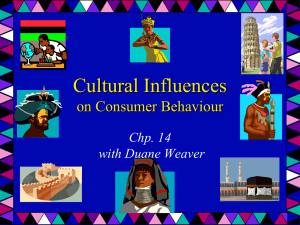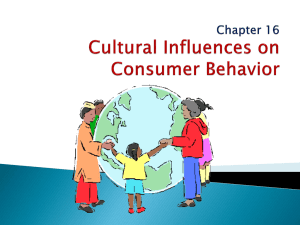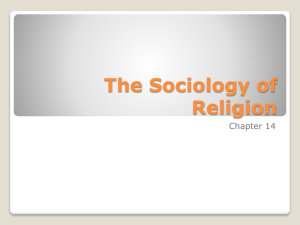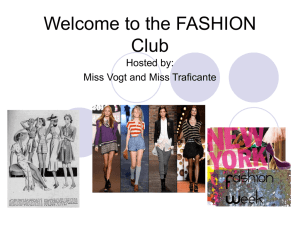File
advertisement
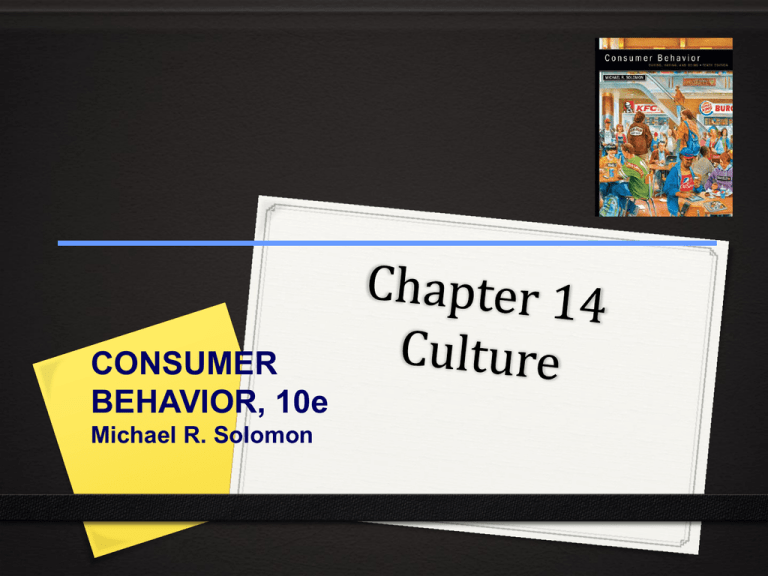
CONSUMER BEHAVIOR, 10e Michael R. Solomon Chapter Objectives When you finish this chapter, you should understand why: 1. A culture is a society’s personality; it shapes our identities as individuals. 3. Many of our consumption activities including holiday observances, grooming, and gift giving are rituals. 4. We describe products as either sacred or profane, and it’s not unusual for some products to move back and forth between the two categories. Chapter Objectives 5. 6. 8. 9. 10. Styles act as a mirror to reflect underlying cultural conditions. Many modern marketers are reality engineers. New products, services, and ideas spread through a population. Different types of people are more or less likely to adopt them. Many people and organizations play a role in the fashion system that creates and communicates symbolic meaning to consumers. Fashions follow cycles. Learning Objective 1: What is Culture 0 A culture is a society’s personality; it shapes our identities as individuals. 0 Includes values, ethics, and the material objects its members produce 0 Culture is the accumulation of shared meanings, rituals, norms, and traditions 0 A consumer’s culture determines the overall priorities he or she attaches to different activities and products. Understanding Culture 0 Products can reflect underlying cultural processes of a particular period: 0 The TV dinner for the United States 0 Cosmetics made of natural materials without animal testing 0 Driving a hybrid car to preserve the earth 0 Texting and driving Learning Objective 3 0 Many of our consumption activities including holiday observances, grooming, and gift giving are rituals. 0 Common rituals: Grooming, gift giving, holiday, rites of passage 0 0 0 0 0 0 0 0 0 0 0 0 Mother’s Day Father’s Day Birthday Anniversary Christmas/Hanukkah Graduation Valentines Day Easter Chinese New Years Wedding Engagement Baby Shower Rituals 0 Rituals are sets of multiple, symbolic behaviors that occur in a fixed sequence and that tend to be repeated periodically 0 Many consumer activities are ritualistic 0 Trips to Starbucks 0 Sunday brunch 0 Haircut every 6 weeks 0 Virtually all consumers practice private grooming rituals, or ceremonies that help us transition from our private self to our public self or back again. 0 Marketers try to get their products to become part of your weekly, daily rituals Gift Giving Ritual 0 We buy (or make) the perfect object, remove the price tag, wrap and deliver the object. 0 There is a gift-giving norm of reciprocity. 0 Gift giving is a form of economic exchange in which the giver transfers and item of value to a recipient, who must reciprocate. 0 Gift giving also involves a symbolic exchange. 0 Gift giving ritual proceeds in three distinct stages: 0 Gestation – giver procures an item to mark an event (structural/ prescribed by culture or emergent/personal and idiosyncratic). 0 Presentation – process of gift exchange, recipient response and donor evaluation of the response. 0 Reformulation – giver and receiver redefine the bond between them to reflect their new relationship after the exchange. This may trigger a negative evaluation if the gift is inadequate due to a violation of the reciprocity norm, which obliges people to return the gesture of a gift with one of equal value. New gift giving rituals thought up by marketers 0 A push present is a present a father gives to the mother to mark the occasion of her giving birth to their child. In practice the present may be given before or after the birth, or even in the delivery room. The giving of push presents has supposedly grown in the United States in recent years. 0 Kindergarten graduation Holidays are filled with rituals 0 Christmas 0 Halloween 0 Valentine’s Day 0 Thanksgiving 0 Easter 0 Passover 0 New Years For Reflection 0 Explain some of your own family holiday traditions. How do they affect your behavior as consumers? Learning Objective 4 0 We describe products as either sacred or profane, and it’s not unusual for some products to move back and forth between the two categories. Sacred and Profane Consumption 0 Sacred consumption: involves objects and events that are set apart from normal activities that are treated with respect or awe 0 Wedding dress 0 Profane consumption: involves consumer objects and events that are ordinary and not special 0 Dress to work Sacralization 0 Sacralization occurs when ordinary objects, events, and even people take on sacred meaning 0 Contamination means that the objects we associate with sacred events become sacred in their own right. 0 For instance, we use ornaments and lights to celebrate the sacred event of Christmas and these ornaments may become sacred. 0 Collecting is the systematic acquisition of a particular object or set of objects Domains of Sacred Consumption 0 A society “sets apart” sacred places because they have religious or mystical significance 0 Sacred places: religious/mystical and country heritage, such as Stonehenge, Mecca, Ground Zero in New York City 0 Sacred people: celebrities, royalty 0 Sacred events: athletic events, religious ceremonies Sacred Souvenir Icons 0 Local products (e.g., regional wine) 0 Pictorial images (e.g., postcards, photos) 0 ‘Piece of the rock’ (e.g., seashells) 0 Literal representations (e.g., mini icons) 0 Markers (e.g., logo-oriented t-shirts) Desacralization 0 Desacralization: when a sacred item/symbol is removed from its special place or is duplicated in mass quantities (becomes profane) 0 Religion has somewhat become desacralized 0 Christmas and Ramadan as secular, materialistic occasions For Reflection 0 Give examples of items that were once sacred but are now materialized and marketed. What are the implications in the shift in reverence to the items in question? Objective 5: Pop Culture 0 Commercial culture based on popular taste. 0 Pop culture, short for popular culture, describes the lifestyle and tastes of the majority of mostly younger people. 0 Music by people like Britney Spears and Hillary Duff are examples of pop culture, as is emo and prep. 0 Pop culture changes with the youth of the world. Popular Culture 0 Styles act as a mirror to reflect underlying cultural conditions. 0 Urban fashion is very popular even though inner-city teens represent only 8% of all people in that age group and have incomes significantly lower than their white suburban counterparts. 0 It is common for mainstream culture to modify symbols from subcultures for a larger audience to consume. Fashion and Pop Culture 0 Characteristics of fashion and popular culture include: 0 Styles reflect more fundamental societal trends (politics and social conditions) 0 A style begins as a unique statement by a small group and spreads 0 Styles originate as interplay between deliberate inventions from designers and businesspeople and spontaneous actions by consumers. 0 Cultural products travel widely. 0 Influential people in the media play a significant role in deciding which will succeed. 0 Most styles wear out and people look for new ways to express themselves. 0 When a style becomes obsolete, others replace it. Retro Nerd Glasses What's behind the sagging pants trend Culture Production System 0 A culture production system is the set of individuals and organizations that create and market a cultural product 0 It has three major subsystems 0 Creative subsystem—responsible for generating new symbols and/or products. 0 Managerial subsystem—responsible for selecting, making tangible, mass producing, and managing the distribution of new symbols and/or products. 0 Communications subsystem—responsible for giving meaning to the new product and providing it with a symbolic set of attributes that are communicated to consumers. Product Placement and Branded Entertainment 0 Insertion of specific products and use of brand names in movie/TV scripts. 0 Directors incorporate branded props for realism. 0 Is product placement a positive or negative when it comes to consumer decision-making? Advergaming 0 Advergaming refers to online games merged with interactive advertisements 0 Advertisers gain many benefits with advergames 0 Plinking is the act of embedding a product in a video Learning Objective 8 0 New products, services, and ideas spread through a population. Different types of people are more or less likely to adopt them. Prerequisites for Successful Adoption Compatibility Innovation should be compatible with consumers’ lifestyles Trialability People are more likely to adopt an innovation if they can experiment with it prior to purchase Complexity A product that is easy to understand will be chosen over competitors Observability Innovations that are easily observable are more likely to spread Relative Advantage Product should offer relative advantage over other alternatives End Learning Objective 9 0 Many people and organizations play a role in the fashion system that creates and communicates symbolic meaning to consumers. The Fashion System 0 The fashion system includes all those people and organizations involved in creating symbolic meanings and transferring these meanings to cultural goods 0 Fashion is code 0 Fashion is context-dependent 0 Fashion is undercoded Behavioral Science Perspectives 0 Psychological and Models of Fashion 0 Economic 0 Sociological 0 Medical Motives and Psychological Models of Fashion 0 Conformity 0 Desire for variety seeking 0 Need to express personal creativity 0 Sexual attraction Learning Objective 10 0 Fashions follow cycles. Fashion Life Cycle Example 0 Introduction stage: small number of music innovators hear a song 0 Acceptance stage: song enjoys increased visibility 0 Regression stage: song reaches stage of social saturation as it becomes overplayed For Reflection 0 What is and what should be the role of fashion in our society? How important is it for people to be in style? What are the pros and cons of keeping up with the latest fashions? Chapter Summary 0 A culture is a society’s personality. 0 Myths are stories that express a culture’s values. 0 Many of our consumption activities include rituals associated with holidays, grooming, rites of passage, and other events. Chapter Summary 0 Products may be sacred or profane and some may shift between the two categories. 0 Styles are like a mirror that reflect culture. 0 We can distinguish between high and low forms of culture. 0 Marketers are also reality engineers. Chapter Summary 0 New products spread through the population. Certain characteristics make it more likely that they will be adopted. 0 The fashion system creates and communicates symbolic meaning for consumers. 0 Fashion follows cycles. 14-43
